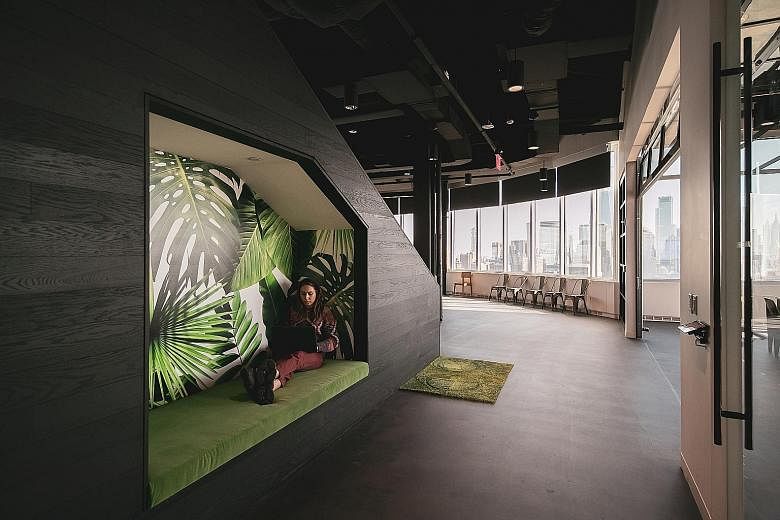NEW YORK • As the head of purchasing at Web retailer Nuts.com, Ms Kathy Skala spends her days monitoring inventory, calling farmers to hear about their crops and placing orders.
At the company's recently renovated headquarters in Jersey City, New Jersey, she works surrounded by colleagues, many seated at long tables lined up in rows.
But sometimes, she takes her laptop and mobile phone to a little alcove for some alone time in the sprawling workplace, designed by architecture firm Gensler. Or she hits the meditation studio or one of the small rooms scattered about where employees can go for uninterrupted stretches.
More than a decade since the swing towards open-plan offices - and the resulting backlash from workers concerned about noise and a lack of privacy - a host of ancillary spaces are cropping up in workplaces, offering employees an escape from their co-workers.
These private spaces include prayer rooms, wellness rooms and libraries - also called quiet cars, like the chatter-free havens on a train. This is not to mention the proliferation of so-called phone booths, mini meeting rooms and all manner of pods, some of them purchased as ready-to-assemble kits.
All of which prompts the question: After pulling down the walls that defined yesterday's workplaces, are we once again putting them up?
"We're swinging back to more construction in offices," said Ms Elizabeth Lowrey, a principal and director of interior architecture at Elkus Manfredi Architects. But she and other experts say the difference between then and now is that private space used to belong exclusively to those at the top of a company's hierarchy, with high-level staff members ensconced in offices of their own. Today, all workers can use the new private spaces - they just have to share them with everyone else.
Open workplaces are not going away any time soon. About 70 per cent of offices in the United States have some form of open plan, according to Mr Christian Beaudoin, a managing director of research and strategy at real estate company JLL.
Such plans took off in the name of teamwork, although researchers in recent years have questioned whether they do encourage collaboration. One Harvard Business School study suggests they can have the opposite effect, finding that face-to-face interactions fell by 70 per cent when firms switched to open offices.
The main reason companies adopted such plans was to cut costs. Doing away with private offices meant less space was needed for each employee, reducing the square footage companies had to rent. Benching arrangements - those long, shared tables with employees sitting side by side - allowed companies to really pack people in.
Confidential conversations, about both business and personal matters, became nearly impossible in a sea of colleagues.
Enter phone booths, those closetlike spaces for placing private calls. Companies build rows of phone booths during renovations or buy prefabricated versions, which range from moderately priced single-person spaces to high-end six-person meeting rooms.
Also popular are "huddle" or "focus" rooms - small spaces where two people can meet or a single person can enjoy some alone time.
When AMC Networks renovated its headquarters in midtown Manhattan, it had the designers eliminate some private offices and add focus rooms, some of which had walls upholstered in sound-absorbing fabric.
It has taken some employees time to get used to the new set-up.
"I would see people on their phone pacing the halls," said Mr Thomas King, vice-president for real estate, facilities and security at AMC, who oversaw the renovation. "I would tell them, 'Go to a focus room.'"
NYTIMES

